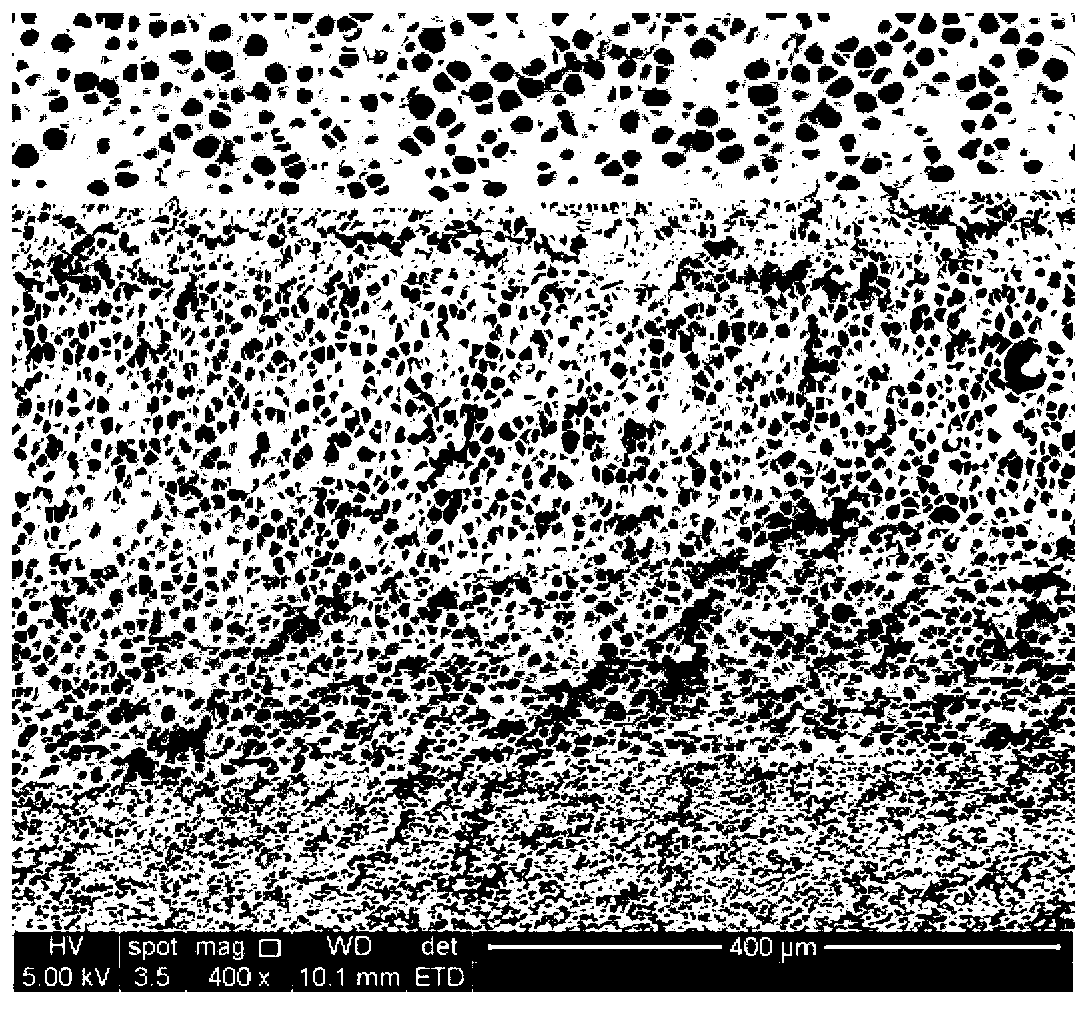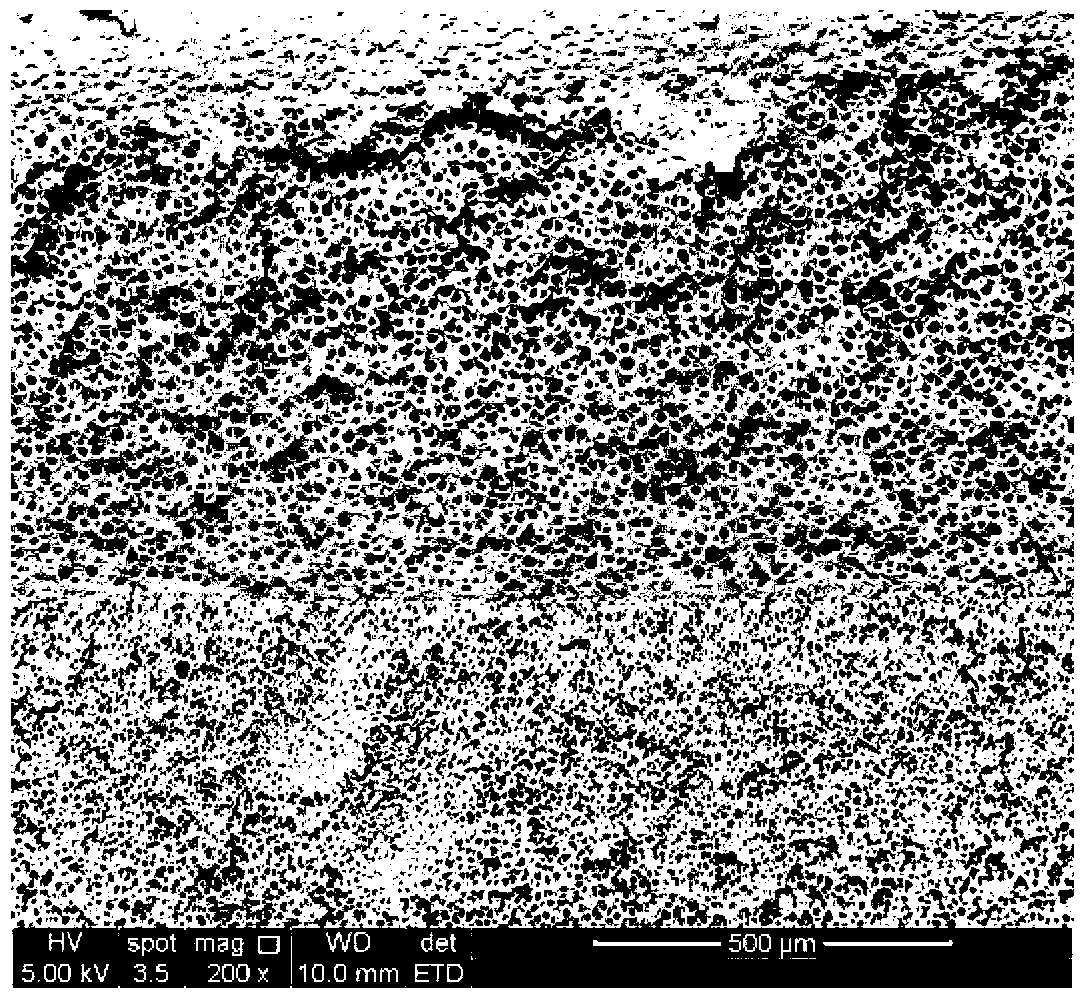Preparation method of polymethyl methacrylate based cell gradient material
A technology of polymethyl methacrylate and gradient materials, which is applied in the field of gradient materials, can solve the problems of not using adhesive-free cell gradient materials, and achieve the effects of environmental protection, simple process, and wide application prospects
- Summary
- Abstract
- Description
- Claims
- Application Information
AI Technical Summary
Problems solved by technology
Method used
Image
Examples
specific example 1
[0028] 1. Disperse 0.5wt.% silver nanoparticles and 0.5wt.% carbon nanotubes evenly into the PMMA matrix to prepare Ag / PMMA and CNTs / PMMA nanocomposites.
[0029] 2. Laminate CNTs / PMMA, Ag / PMMA and pure PMMA sheets, melt and hot press at 210°C to form a gradient composite material.
[0030] 3. Put the prepared gradient composite material in the autoclave, blow it with a small amount of carbon dioxide for 3 minutes, then raise the temperature of the autoclave to 95°C, then use the syringe pump to inject carbon dioxide to 20MPa, and saturate at constant temperature and pressure for 6h. Gradient composite materials saturated with carbon dioxide adsorption are obtained.
[0031] 4. Quickly unscrew the pressure relief valve to release the pressure to normal pressure, remove the heating device after 60 seconds, put the autoclave into the ice-water mixture to cool down, and obtain the cell gradient material.
[0032] The cell structure of the cell gradient material is as follows fi...
specific example 2
[0034] 1. 0.5wt.% silver nanoparticles and 1wt.% silver nanoparticles were evenly dispersed in the PMMA matrix to prepare Ag / PMMA nanocomposites with different contents.
[0035] 2. Laminate 0.5wt%Ag / PMMA, 1wt.%Ag / PMMA and pure PMMA sheets, melt and hot press at 210°C to form a gradient composite material.
[0036] 3. Put the prepared gradient composite material in the autoclave, blow a small amount of carbon dioxide into the autoclave for 3 minutes, then raise the temperature of the autoclave to 50°C, and then use a syringe pump to inject carbon dioxide to reach 12MPa, and saturate at constant temperature and pressure for 6h to obtain Gradient Composite Materials Saturated by Carbon Dioxide Adsorption.
[0037] 4. Quickly unscrew the pressure relief valve to release the pressure to normal pressure, remove the heating device after 180s, put the autoclave into the ice-water mixture to cool down, and obtain the cell gradient material.
[0038] The cell structure of the cell gra...
specific example 3
[0040] 1. 1wt.% silver nanoparticles and 1wt.% carbon nanotubes were evenly dispersed into PMMA matrix to prepare Ag / PMMA and CNTs / PMMA nanocomposites.
[0041] 2. Laminate CNTs / PMMA, Ag / PMMA and pure PMMA sheets, melt and hot press at 210°C to form a gradient composite material.
[0042] 3. Put the prepared composite material in the autoclave, blow it with a small amount of carbon dioxide for 3 minutes, then raise the temperature of the autoclave to 65°C, and then use a plug pump to inject carbon dioxide to reach 7.5MPa, and saturate at constant temperature and pressure for 6h, to obtain Gradient Composite Materials Saturated by Carbon Dioxide Adsorption.
[0043] 4. Quickly unscrew the pressure relief valve to release the pressure to normal pressure, remove the heating device after 10 seconds, put the autoclave into the ice-water mixture to cool down, and obtain the cell gradient material.
[0044] The cell structure of the cell gradient material is as follows image 3 As ...
PUM
| Property | Measurement | Unit |
|---|---|---|
| thickness | aaaaa | aaaaa |
| thickness | aaaaa | aaaaa |
| density | aaaaa | aaaaa |
Abstract
Description
Claims
Application Information
 Login to View More
Login to View More - R&D
- Intellectual Property
- Life Sciences
- Materials
- Tech Scout
- Unparalleled Data Quality
- Higher Quality Content
- 60% Fewer Hallucinations
Browse by: Latest US Patents, China's latest patents, Technical Efficacy Thesaurus, Application Domain, Technology Topic, Popular Technical Reports.
© 2025 PatSnap. All rights reserved.Legal|Privacy policy|Modern Slavery Act Transparency Statement|Sitemap|About US| Contact US: help@patsnap.com



